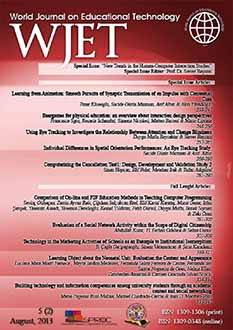Comparison of On-line and F2F Education Methods in Teaching Computer Programming
Comparison of On-line and F2F Education Methods in Teaching Computer Programming
Author(s): Sevinç Gülseçen, Zerrin Ayvaz Reis, Çiğdem Selçukcan Erol, Elif Kartal Karataş, Murat Gezer, Irfan Şimşek, Yasemin Asaadi, Yasemin Derelioğlu, Kemal Yıldırım, Fatih Gürsul, Duygu Mutlu-Bayraktar, Burak Sişman, Zeki ÖzenSubject(s): Education, ICT Information and Communications Technologies, Distance learning / e-learning
Published by: Birlesik Dunya Yenilik Arastirma ve Yayincilik Merkezi
Keywords: E-learning; Computer Programming; Online learning; Information technology; LMS;
Summary/Abstract: Although online education provides opportunities to people who traditionally do not have access to universities, there is a need for more empirical studies to gain better understanding on how to deliver quality online education, especially when the subject of the course is related with IT. Learning to program is a complicated process. This study aims to find out the difference between students’ performance in online and face-to-face (F2F) settings during a computer programming course in the fall semester of the year 2010. The study was conducted at the Department of Mathematics, Faculty of Science,Istanbul University. This online course is one of the required courses for students majoring in Mathematics. It is delivered in a learning management system developed in house through a project funded by Istanbul University.The goal is to introduce students with structured programming using the programming language C. Two topics -“Functions in C Programming” and “Loops in C Programming” - were presented to students online and F2F. The total of 62 students formed two groups: the online and F2F groups. The content analysis statistical technique is used, as well as a questionnaire consisting of open-ended questions, which performed as a data collection tool to find out the views of the students in context to the process. While some results concluded that the performance of online students was satisfactory, but that their aggregate final grade was significantly lower than that of students who took an equivalent F2F class, others arrived at a conclusion reporting that there were no significant differences in overall outcomes. In case of making transition from F2F to online mode of teaching, prepossession about a new way of teaching is always an important barrier in students’ perceptions. One of the further researches is investigation of strategies for incorporating blended learning opportunities in programming courses.
Journal: World Journal on Educational Technology: Current Issues
- Issue Year: 5/2013
- Issue No: 2
- Page Range: 291-300
- Page Count: 9
- Language: English

